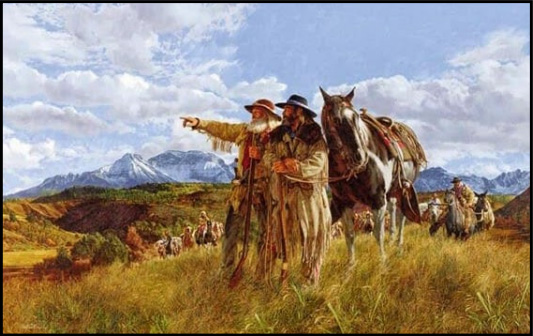Blogs


Mountain Men
There would be no mountain men without the fur trade. This enterprise was driven by the fashions of the time. Euro-Americans demanded hats made of beaver skins and coats made of buffalo hides. In China and Europe, there was a great clamor for otter pelts and other skins. To answer these calls, powerful fur companies were formed. The British controlled the Hudson Bay Company, the French dominated the North West Company and John Astor monopolized the American Fur Company and later the Pacific Fur Company. These companies, and the many other smaller regional fur outfits, would flourish economically for the first half of the nineteenth century.
There were essentially three realms of business: the Maritime trade, the Rocky Mountain trade and the Upper Missouri fur trade. All these regions had particular circumstances and hence very different methods of operating. The Maritime trade operated primarily on the Pacific coast, and required shiploads of goods, as well as fearless sailors to trade with the many different Indian Nations. In this realm, the most desired pelts were otter and beaver, which were killed and cured by the local Indians.
The Upper Missouri trade relied on the Indian tribes to bring their buffalo skins to trading posts and forts. There, the robes were sold and then sent to St. Louis, via river.
The Rocky Mountain realm was quite different, and beaver was the fur of choice. The beaver were trapped mainly by Canadian and American mountain men traveling in large troops. The hides were sold at a yearly rendezvous, with the buyers traveling overland to the designated site and then hauling out the furs via mule train or wagon train to be sold in the cities. This system allowed the mountain men to stay in the wilderness year-round, as they did not have to travel to a trading post to sell their pelts.

The mountain man was a slave to the fur market created by the competing fur companies. In a good year, a beaver pelt could be worth ten dollars; in a bad year, it brought only half that amount. The control a company had over a trapper depended on his contract. ‘Engages’ were men who were supplied and salaried by the company. The furs they collected were the property of the company. ‘Skin Trappers’ were outfitted by the company in exchange for a set share of their pelts at the end of the season. The ‘Free-Trapper’ was at the top of this social pyramid, and was beholden to no company. He outfitted himself and trapped wherever and with whomever he pleased.
Contrary to the common belief of lone trappers plying the waters for beaver, the mountain men usually traveled in brigades of forty to sixty men, including camp tenders, meat hunters, scouts and interpreters. From base camps, they would fan out and trap in parties of two or three. It was then that the trappers were most vulnerable to Indian attack. Indians were a constant threat, and confrontation was common. Once the beaver were trapped, they were skinned immediately; the pelts were allowed to dry, and then were folded in half, fur to the inside. Unlike buffalo skins, beaver pelts were compact, light and portable.
The mountain man’s life was not ruled by the calendar or clock, but by the climate and seasons. The legends and feats of famous mountain men such as Jedediah Smith, Jim Bridger and Christopher (Kit) Carson, to name but a few, have survived the test of time because there was truth to the tales they told. The life of the mountain man was rough, and brought him face to face with death on a regular basis; sometimes through the slow agony of starvation, dehydration, burning heat, or freezing cold and sometimes by the surprise attack of animal or Indian.
But the rewards for these hardships could also be bright. Jedediah Smith came out of the wilderness in eleven years with a half-million-dollar fortune, in today’s money. The lucrative earnings of the fur trade helped propel John Astor to his status as America’s richest man.
Joe Meek, a famous trapper and early pioneer in the Oregon Country, once wrote of the mountain men: “…They prided themselves on their hardihood and courage, even on their recklessness and profligacy. Each claimed to own the best horse; to have had the wildest adventure; to have made the narrowest escapes; to have killed the greatest number of bears and Indians; to be the greatest favorite with the Indian belles, the greatest consumer of alcohol, and to have the most money to spend…”
It is estimated that over one thousand mountain men roamed the American West from 1820 to 1840, the heyday of the fur trade.


